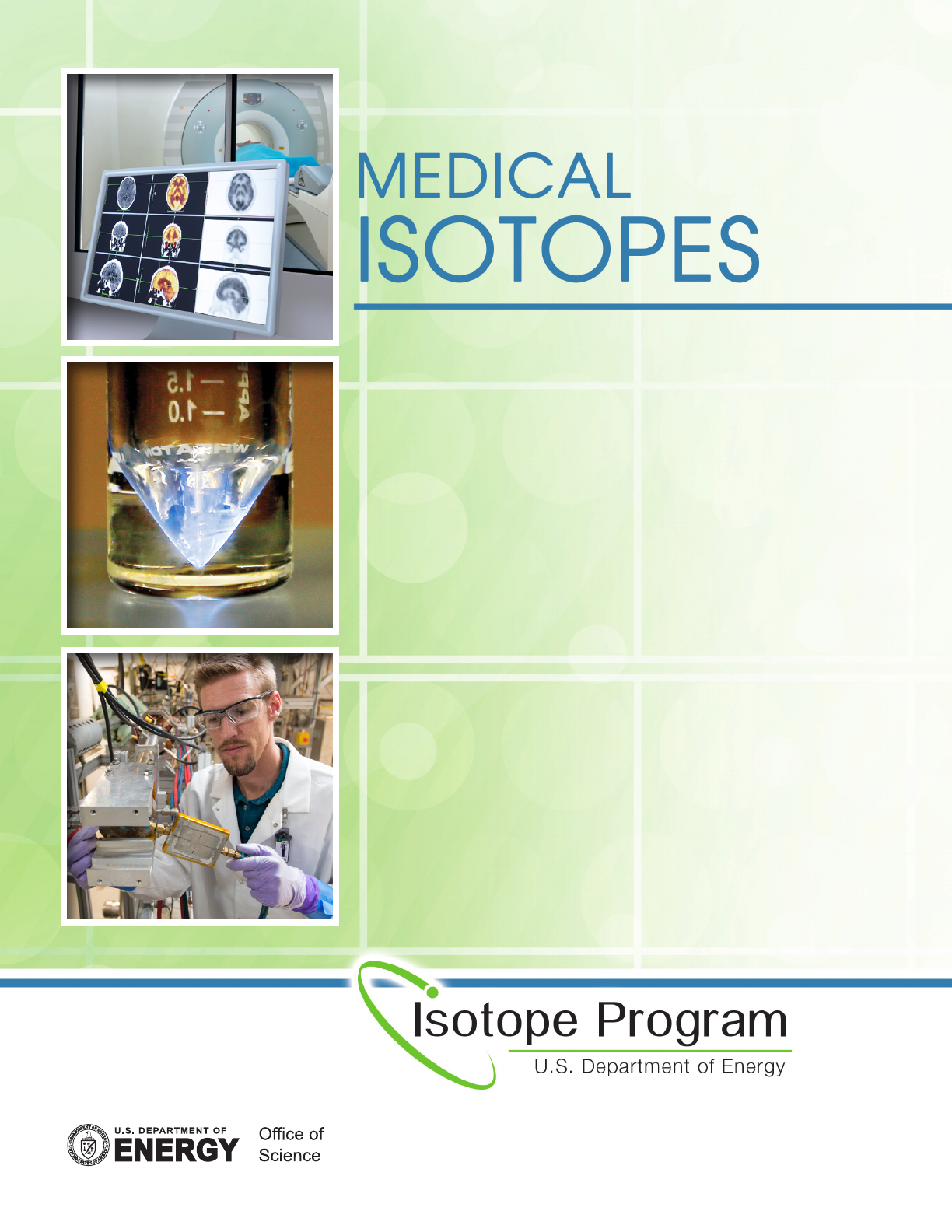

Advancing Medical Innovation
The routine use of radioisotopes in the elds of biology, medicine, and pharmaceuticals has led to safer
and more effective diagnoses and treatments of numerous medical conditions, including cancer. As a
result, millions of patients worldwide have experienced improved health and quality of life.
Through its extensive network of national laboratories
and partnering universities, the U.S. Department of
Energy Isotope Program develops, produces, and
supplies isotopes that are critical components of
these medical diagnostic and treatment options.
Particle accelerators, research reactors, medical
cyclotrons, and radiochemical processing
laboratories are among the facilities that
help the program meet this objective.
The DOE Isotope Program’s portfolio has
grown over time to include more than 35
medically relevant isotopes available
through the National Isotope Development
Center (NIDC) catalog (www.isotopes.gov),
with several more under investigation
at universities and national laboratories.
Diagnostic Imaging
Some isotopes emit radiation,
enabling specialists to visual-
ize the progression of disease
throughout the body based on
biological and physiological
features. With these images,
doctors can better assess how
to treat the diseased tissue and
also can detect small cancers
before they metastasize.
Medical Research
The development of new
isotopes is critical to advance-
ments in the medical eld,
ranging from new molecular
imaging agents to targeted
radiotherapeutics. Additionally,
new production methods that
provide adequate supply and
reduce costs are under
constant pursuit.
Cancer Therapy
Certain radioisotopes serve as
therapeutic agents by delivering
highly targeted radiation to
cancerous cells while sparing
side effects to normal tissues.
These radioisotopes are often
administered by either direct
infusion or attachment to targeting
vehicles, like monoclonal
antibodies or peptides.

Medical Isotopes Available from the DOE Isotope Program
Medical Isotopes Under Development
ISOTOPE HALF-LIFE APPLICATION
Ac-225
10.0 d Cancer therapy R&D (used directly or as the parent of Bi-213)
Ac-227
21.8 y Cancer therapy
Al-26
717,000 y Radiotracer
As-73
80.3 d Radiotracer
At-211
7.21 h Cancer therapy R&D (leukemia, lymphoma, multiple myeloma)
Au-199
3.14 d Treatment of arthritis and cancer therapy
Be-7
53.2 d Radiotracer
Cd-109
462 d Diagnostic imaging
Cf-252
2.65 y Cancer therapy
Co-60
5.27 y Cancer therapy
Cu-67
2.58 d Cancer therapy/diagnostics and planar imaging
Fe-52
8.28 h PET imaging
Fe-55
2.74 y Medical research
Ge-68
271 d Parent of Ga-68; PET imaging
Lu-177
6.65 d Cancer therapy
Na-22
2.60 d Radiotracer
Ra-224/Pb-212/Bi-212
10.6 h Cancer therapy R&D
Ra-223
11.4 d Cancer therapy
Se-72
8.40 d Diagnostic imaging and generator for As-72
Se-75
120 d Radiotracer
Sn-117m
14.0 d Bone cancer pain relief
Sr-82
25.3 d Parent of Rb-82; PET imaging
Sr-89
50.6 d Bone cancer pain relief
Sr-90
28.8 y Parent of Y-90; cancer therapy
Tc-96
4.28 d Medical research
Te-123m
119 d Diagnostic imaging
Th-227
18.7 d Cancer therapy R&D
Th-228
1.91 y Cancer therapy R&D
W-188
69.8 d Parent of Re-188; cancer therapy R&D
Xe-127
36.4 d Diagnostic imaging
Xe-129
8.88 d Polarized lung imaging
Y-86
14.7 h PET imaging
Y-88
107 d Y-90 substitute in cancer R&D
Zn-65
244 d Medical research
ISOTOPE HALF-LIFE APPLICATION
Bi-205
15.3 d Potential theranostic isotope
Ca-47
4.54 d Radiotracer
Ce-134
3.16 d Imaging analog for Ac-225
C-14
5,700 y Radiotracer
Fe-59
44.5 d Radiotracer
Gd-153
240 d Brachytherapy and bone density measurement
Ir-192
73.8 d Cancer therapy
Kr-76
14.8 h Parent of Br-76; PET imaging
Mn-52
5.59 d Bi-modal imaging
Nb-90
14.6 h PET imaging
Pt-195m
4.01 d Biomedical imaging
Re-186
3.72 d Accelerator-based production for high-specific activity; potential theranostic isotope
Re-189
24.3 h Potential theranostic isotope
Rn-211
14.6 h Parent of At-211; generator for At-211
Sc-47
3.35 d Cancer therapy R&D
Te-119
16.1 h Parent of Sb-119; cancer therapy R&D
Ti-44*
59.1 y Parent of Sc-44; potential therapeutic isotope
U-230
20.8 d Parent of Th-226; cancer therapy R&D
Xe-129
8.89 d Lung imaging
*Now available for evaluation. Contact the NIDC to request samples.

ORNL 2019-G00225/DLR
Front Cover Captions: Top image: CT Scan of brain (image courtesy of Oak
Ridge National Laboratory); Center image: Sample of actinium-225 in a glovebox at
ORNL’s Radiochemical Engineering Development Center (image courtesy of Oak
Ridge National Laboratory); Bottom image: Preparing for production of theranostic
radioisotopes at ANL’s Low Energy Accelerator Facility (image courtesy of Argonne
National Laboratory)
Other Photo Credits: ORNL’s Rose Boll and Jody Rayburn conduct
medical radioisotope research (Image courtesy of Oak Ridge National Laboratory)
